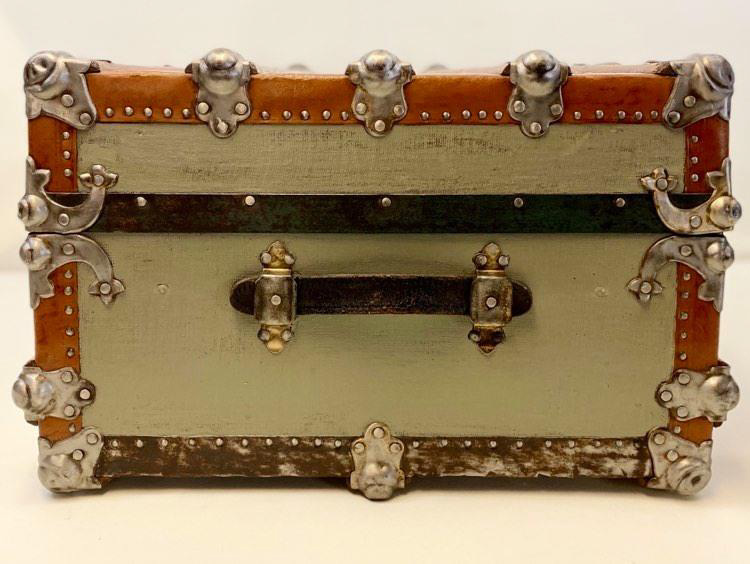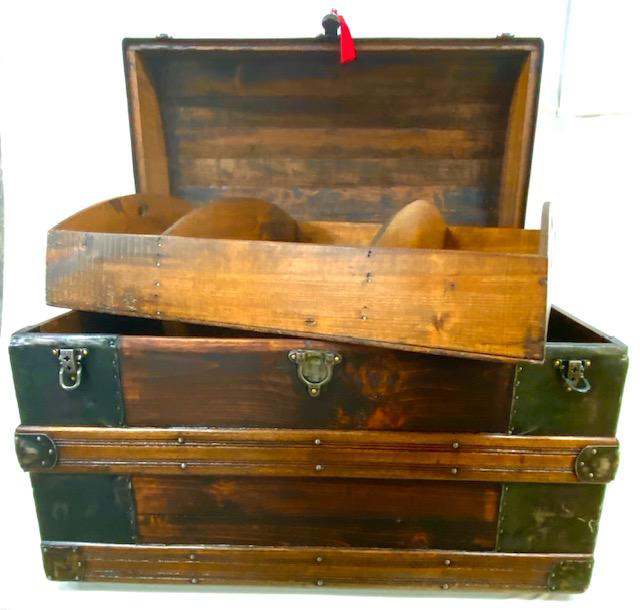historical Context
Steamer Trunk is a broad term, used to cover trunks ranging from the mid-late 1800s to early 1900s. The true steamer trunk or cabin trunk was small in size, perfect for stowing under a cabin bunk. Like today, there were restrictions on baggage size while traveling. The larger trunks were always stored into the hull of the ship and were unloaded once you reach your final destination.
Steamer Trunks have a brief history of around thirty years, although trunks and chests were around for hundreds of years, the history of steamer trunks began in the mid 1800s. It all started with a traveling singer called Jenny Lind, who had a distinct style of trunk while traveling around. The trunk, when looking at its side, had an hourglass shape. Prior to that, people normally had what was known as a stagecoach trunk, which was basic, robust and often covered in animal hide. The Jenny Lind style trunk was the predecessor of the more ornate styles of trunks that were to come to the consumers during the Victorian era.
The dome top, which is also known as the barrel top or camelback and other styles included the monitor trunk and beveled top trunk. The names describe various styles of trunks, like the name of ‘steamer trunk,’ these are broad terms which were not used by manufacturers to describe the trunk to the customers. These styles have since been categorized overtime, by their varying styles and origins.
The origin of the monitor or waterfall trunk is questionable. It has a flat top, rounded front and rear ends and is typically covered in leather or tin. It was supposedly named after a civil war era, ironclad battleship, called the USS Monitor. This is because the top of the trunk resembled the top of this particular ship, but like mentioned before, this theory isn’t proven. If you go on to research this particular ship online, you will find that their is no resemblance.
The saratoga trunk is known for being highly decorative and ornate. With its dome top, it acquired the name from a popular health resort which was frequented by the wealthy in Saratoga Springs, New York.
Neither of these names were used by manufactures to describe the style of trunk that they were selling. All manufactures of the time, like today, had a range of products to suited the budget of their client base. From the basic flat top truck to the more grand and opulent, barrel or dome top trunk. There is a myth as to why there is flat top trunks and dome top trunks, which for a long time I believed myself, as it did make logical sense. But, with a little research and looking at old photos of baggage handlers and porters loading trunks onto the ships, made me think otherwise. The myth goes, that the wealthy, upper-class passengers did not like the fact that their baggage was being stacked with the lower-class passenger luggage. So, the manufactures started making dome topped trunks, so that the baggage handlers would not stack other bags on top of theirs. Which makes sense, until you look at old photos of porter and luggage handlers loading these ships. In the photos that I have seen, most of these were stacked up on their end, and also when you think about it, some of these trunks were huge, weighing in excess of over a hundred pounds, empty. So when loading, you always place the heavier item at the bottom of the pile, but who knows? Shipping companies had their own way of doing things, as they do today. So to coin a Maine phrase….. Its hard telling, not knowing.
As like today, the manufacturers of that time produced luggage to fit all tastes and budgets. Trunks were manufactured all across Europe and the East and West coast of the American. With manufactures in almost every town, city and state in this great country.



Thank you for the wonderful work you do! The trunk I purchased from you yesterday looks wonderful in the house. It was also hard not to buy the stagecoach, will all the history they posses. Thanks again for the time and effort you clearly put into your restoration work.
-Bill Barker
Thank you for delivering my beautiful trunk! Although I was originally a little taken back by the greenish tint of the wood, it is now really growing on me and looks great in the front room with the other neutral colors.
-Sandy MacDonald
Finding Maine Steamer Trunk Company was an unexpected and pleasant surprise for my husband and I. I have been wanting an antique trunk for many years now but, have never found one in a condition that I would want in my home. The trunk I purchased is absolutely gorgeous and will make a lovely collectible. We love it so much and think it has been so beautifully refurbished that we plan on bringing a trunk we already own to be refreshed. Such an original and thoughtful gift for somebody who loves the history of travel and enjoys having one of a kind items in their collections!
– Jifka McCarthy
My wife and I had the great pleasure of being their first customer. Johns craftsmanship and attention to detail are second to none. We also learned a little something about the history of the pieces. Thanks again for a great piece that we’ll treasure forever. Highly recommended.
– Keith Mercier
Thank you John at Maine Steamer Trunk Company for refinishing our family trunk! It’s absolutely beautiful!
– Johnna Coggin
We love how it came out! And even though this isn’t an “heirloom” piece, we have so many memories of littles playing under the table, and rolling out pie dough when they got older. Glad you brought it back to life!
– Joy Orz
Trunks for Sale
GET IN TOUCH FOR A QUOTE
Disclaimer ~ All prices given online from photos are ball park figures only. In order to receive an accurate price, we would need to see the piece in person.
